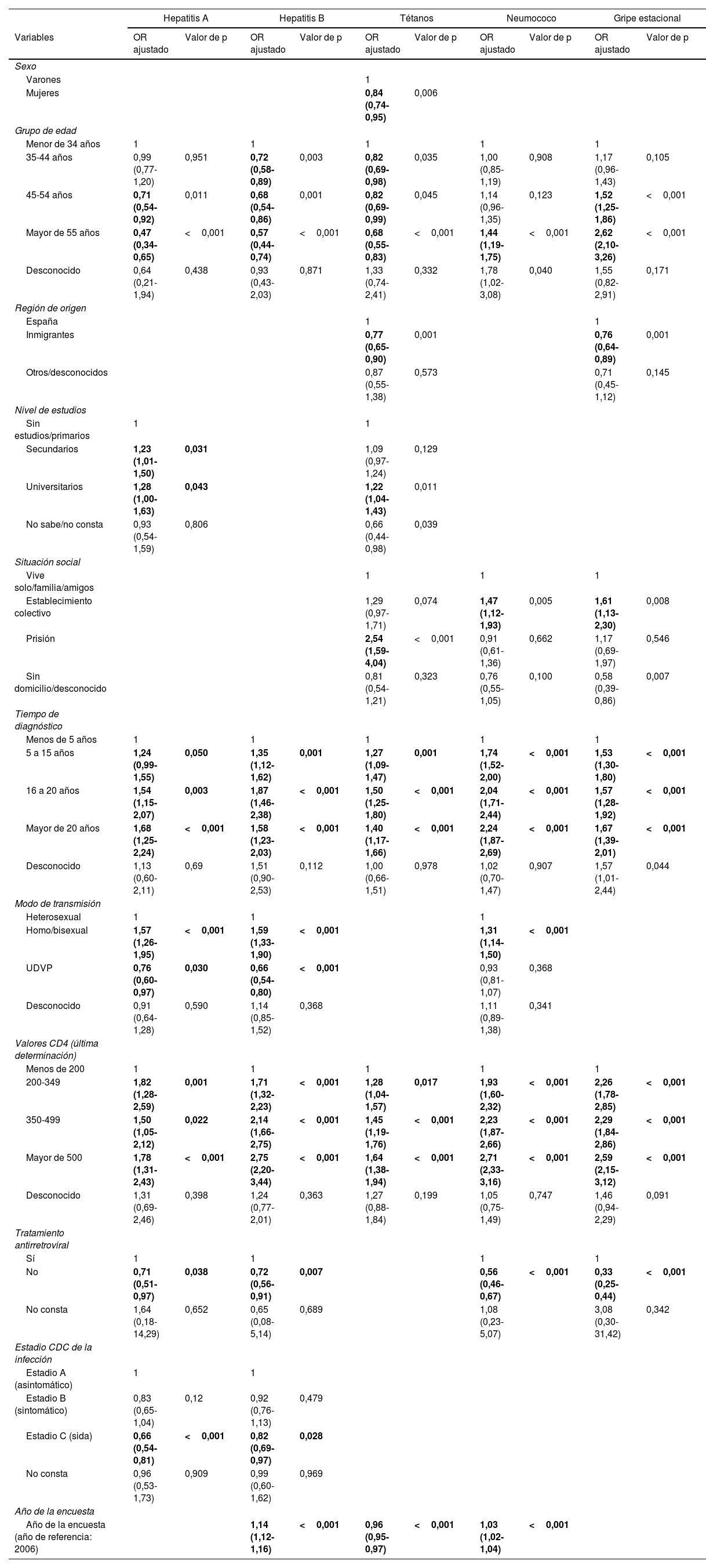Evaluar la tendencia en la vacunación de hepatitis A, hepatitis B, neumococo, tétanos y gripe estacional en personas con infección por VIH, y analizar sus factores asociados.
MétodosComo fuente se utilizó la Encuesta Hospitalaria de pacientes con VIH, estudio transversal anual realizado un día prefijado (2006-2021). Se incluyeron los pacientes hospitalizados o atendidos ambulatoriamente. Se analizaron las tendencias en vacunación y los factores asociados mediante regresión logística.
ResultadosSe incluyeron 8.643 participantes. Los porcentajes de vacunación aumentaron hasta el 65,3% para hepatitis A, el 83,7% para hepatitis B, el 49,3% frente a tétanos, el 68,9% frente a neumococo y el 74,5% para la gripe estacional en 2021. Los factores asociados positivamente con la vacunación fueron tener mayor edad para la vacuna de neumococo y gripe; mayor nivel de estudios para hepatitis A y tétanos; residir en un establecimiento colectivo o en prisión para tétanos, neumococo y gripe; y haber adquirido el VIH mediante relaciones sexuales entre varones para hepatitis A, hepatitis B y neumococo. Además, estar recibiendo tratamiento antirretroviral y tener un alto recuento de CD4 se asoció positivamente con la vacunación de todas estas enfermedades. Los factores asociados inversamente con la vacunación fueron tener mayor edad (hepatitis A, hepatitis B y tétanos), ser inmigrante (tétanos y gripe estacional) y ser usuario/ex usuario de drogas inyectadas para hepatitis A y hepatitis B.
ConclusionesLa vacunación en personas con VIH ha aumentado en el periodo de estudio. Los resultados se ajustan a las recomendaciones en esta población, aunque queda margen para alcanzar los indicadores de vacunación establecidos.
To assess the trend in hepatitis A, hepatitis B, pneumococcal, tetanus and seasonal influenza vaccination in people with HIV infection and to analyse associated factors.
MethodsThe hospital survey of patients with HIV, an annual cross-sectional study conducted on a fixed day (2006-2021), was used. Inpatients and outpatients were included. Trends in vaccination and associated factors were analysed using logistic regression.
ResultsA total of 8643 participants were included. Vaccination rates increased to 65.3% for hepatitis A, 83.7% for hepatitis B, 49.3% for tetanus, 68.9% for pneumococcal and 74.5% for seasonal influenza in 2021. Factors positively associated with vaccination were older age for pneumococcal and influenza vaccination; higher educational level for hepatitis A and tetanus; living in a closed institutions or prison for tetanus, pneumococcal and influenza; and having acquired HIV through sex between men for hepatitis A, hepatitis B and pneumococcal. In addition, being on antiretroviral treatment and having a high CD4 count were positively associated with vaccination for all these diseases. Factors inversely associated with vaccination were being older (hepatitis A, hepatitis B and tetanus), being an immigrant (tetanus and seasonal influenza) and being an injection drug user/ex-user for hepatitis A and hepatitis B.
ConclusionsVaccination in people with HIV has increased in the study period. The results are in line with the recommendations in this population, although there is still room to reach the established vaccination indicators.
Artículo
Socio de la Sociedad Española de Enfermedades Infecciosas y Microbiología Clínica

Para acceder a la revista
Es necesario que lo haga desde la zona privada de la web de la SEIMC, clique aquí
Comprando el artículo el PDF del mismo podrá ser descargado
Precio 19,34 €
Comprar ahora











